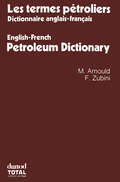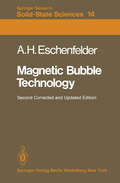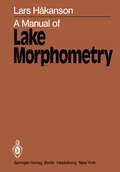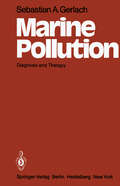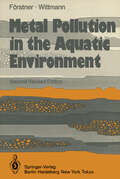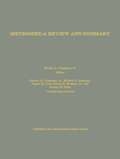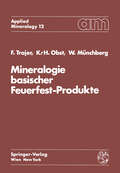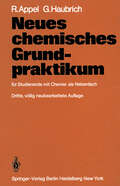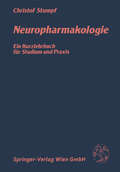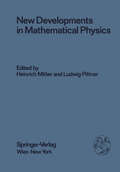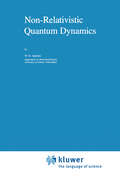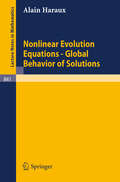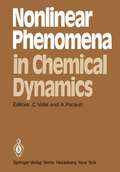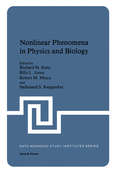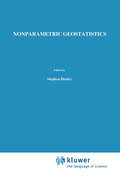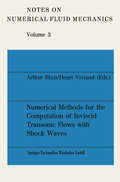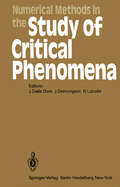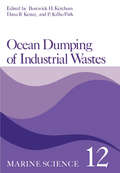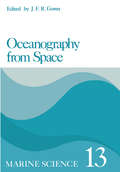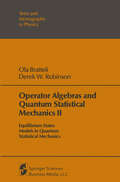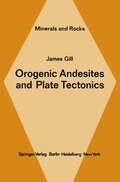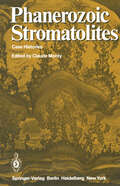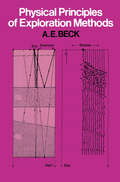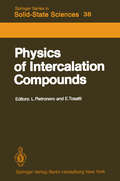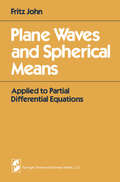- Table View
- List View
Les termes pétroliers: Dictionnaire anglais-français. English-French Petroleum Dictionary
by Michel Arnould Fabio ZubiniMagnetic Bubble Technology (Springer Series in Solid-State Sciences #14)
by A. H. EschenfelderThe popularity of the First Edition of this book has been very gratifying. It confirms that there is a genuine need for a text covering the magnetic bubble technology. We are pleased that the readers have found that this book satisfies that need. It has been used as a text for courses in both universities and industry, and as a reference manual by workers active in the field. To meet the need for more copies of the book it seemed preferable to publish a second edition rather than merely a second printing. There has been some significant progress, even in the short time since the initial printing, and we wanted to include that. At the same time we would like to provide the new copies at the lowest possible cost so that they are more easily obtained by students. For this reason the new edition is in soft cover and the recent progress has been described in a final chapter rather than incorporated into the original chapters. This eliminates the expense of resetting and repaging the original text. At the same time up-to-date references have been added and typographical errors have been corrected in the original chapters. It is our hope that this edition will be useful to those with an interest in the fascinating field of magnetic bubbles.
Marine Pollution: Diagnosis and Therapy
by Sebastian A. GerlachWhen, in 1966, the Gennan Research Society directed the attention of oceanographers in the Federal Republic of Ger many to problems of marine pollution, I was not enthusiastic. Emphasis on this problem area meant that other important research plans had to be postponed. But the lectures at the Third International Oceanographic Congress, September 1970, in Tokyo, and at the FAO Conference on Marine Pollution and its Effects on Living Resources and Fishing, December 1970, in Rome, convinced me that research on problems of marine pollution is a social obligation, and that the oceanographer has to take a stand. I issued public warnings about the continuing use of pesticides and had to defend myself against protests by the fishing industry and many colleagues who were, in Novem ber 1970, unaware of the extent of the threat. Thus, I was required by my profession to acquire an overview of the prob lems of ocean pollution. In 1971 I only needed to familiarize myself with some one hundred bibliographical items. In the interim, the flood of data has risen dramatically, and in the year 1975, no fewer than 868 publications under the heading of "Marine Pollution" were reported (Table 1). It is, therefore, more and more diffi cult to distinguish new results of scientific research from the many repetitions and variations, and I fear that from year to year my efforts to illustrate the actual status of the problem at a given moment will be subject to more gaps.
Metal Pollution in the Aquatic Environment (Springer Study Edition)
by U. Förstner G. T. WittmannAquatic chemistry is becoming both a rewarding and substantial area of inquiry and is drawing many prominent scientists to its fold. Its literature has changed from a compilation of compositional tables to studies of the chemical reactions occurring within the aquatic environments. But more than this is the recognition that human society in part is determining the nature of aquatic systems. Since rivers deliver to the world ocean most of its dissolved and particulate components, the interactions of these two sets of waters determine the vitality of our coastal waters. This significant vol ume provides not only an introduction to the dynamics of aquatic chem istries but also identifies those materials that jeopardize the resources of both the marine and fluvial domains. Its very title provides its emphasis but clearly not its breadth in considering natural processes. The book will be of great value to those environmental scientists who are dedicated to keeping the resources of the hydrosphere renewable. As the size of the world population becomes larger in the near future and as the uses of materials and energy show parallel increases, the rivers and oceans must be considered as a resource to accept some of the wastes of society. The ability of these waters and the sediments below them to accommodate wastes must be assessed continually. The key questions relate to the capacities of aqueous systems to carry one or more pollutants.
METROMEX: A Review and Summary (Meteorological Monographs #18)
by Stanley ChangnonThe objects of the American Meteorological Society are "the development and dissemination of knowledge of meteorology in all its phases and applications, and the advancement of its professional ideals." The organization of the Society took place in affiliation with the American Association for the Advancement of Science at Saint Louis, Missouri, December 29, 1919, and its incorporation, at Washington, D. C., January 21, 1920. The work of the Society is carried on by the Bulletin, the Journal, and Meteorological Monographs, by papers and discussions at meetings of the Society, through the offices of the Secretary and the Executive Secretary, and by correspondence. All of the Americas are represented in the membership of the Society as well as many foreign countries.
Mineralogie basischer Feuerfest-Produkte (Applied Mineralogy Technische Mineralogie #12)
by Felix Trojer Karl-Heinz Obst Wolfgang MünchbergNeuropharmakologie: Ein Kurzlehrbuch für Studium und Praxis
by C. StumpfDas vorliegende Buch stellt die auf den letzten Stand des Wissens gebrachte und erweiterte Grundlage der Vorlesung "Neuropharmakologie" dar, die ich seit Jahren für Medizinstudenten an der Universität Wien halte. Ebensowenig wie vom Hörer dieser Vorlesung werden vom Leser dieses Buches Vorkenntnisse in klinischen Fächern vorausgesetzt; alle Begriffe aus der klinischen Medizin, aber auch aus anderen Fächern, sind im Text oder in Fußnoten erklärt. Der Titel "Neuropharmakologie" wurde nicht nur deswegen gewählt, weil er dem Titel der Vorlesung entspricht, sondern auch weil er den thematischen Inhalt des Buches am besten umreißt: die (experimentelle) Pharmakologie aller zentral wirksamen Pharmaka sowie der Lokalanästhetika und verwandter Sub stanzen. Im übrigen ist "Neuropharmakologie" auch sonst ein genau umschrie bener Begriff, stellt doch dieser Wissenszweig, etwa nach der Unterteilung der International Brain Research Organization (IBRO), eines der neun Fachgebiete der sogenannten neurobiologischen Wissenschaften ("Neurosciences") dar. Nicht nur in der Neuropharmakologie ist noch vieles hypothetisch. Durch die Darstellung möglichst vieler Hypothesen zu den verschiedenen Fragestellun gen - die Auswahl der dargestellten Hypothesen ist notwendigerweise subjektiv - sollte insbesondere beim Medizinstudenten der Eindruck vermieden werden, daß etwa alle Wirkungsmechanismen schon bekannt wären. Selbst verständlich bedeutet die getroffene Auswahl nicht unbedingt, daß nicht erwähnte Hypothesen einen geringeren wissenschaftlichen Wert hätten als die erwähnten. Im Text verwendete Substanzbezeichnungen sind ausschließlich internationale Freinamen ("international non-proprietary names", I.N.N.) oder Trivialnamen.
New Developments in Mathematical Physics: Proceedings of the XX. Internationale Universitätswochen für Kernphysik 1981 der Karl-Franzens-Universität Graz at Schladming (Steiermark, Austria), February 17-26, 1981 (Few-Body Systems #23/1981)
by H. Mitter L. PittnerNon-Relativistic Quantum Dynamics (Mathematical Physics Studies #2)
by W.O. AmreinThe bulk of known results in spectral and scattering theory for Schrodinger operators has been derived by time-independent (also called stationary) methods, which make extensive use of re solvent estimates and the spectral theorem. In very recent years there has been a partial shift of emphasis from the time-indepen dent to the time-dependent theory, due to the discovery of new, essentially time-dependent proofs of a fair number of the principal results such as asymptotic completeness, absence of singularly con tinuous spectrum and properties of scattering cross sections. These new time-dependent arguments are somewhat simpler than the station ary ones and at the same time considerably closer to physical in tuition, in that they are based on a rather detailed description of the time evolution of states in configUration space (whence the designation "geometric methods" used by some authors). It seemed interesting to me to present some of these new meth ods from a strictly time-dependent point of view, by considering as the basic mathematical object strongly continuous unitary one parameter groups and avoiding the spectral theorem completely. The present volume may be viewed as an essay in this spirit. It is an extended version of a course taught in 1979 at the University of Geneva to undergraduate students enrolled in mathematical physics.
Nonlinear Evolution Equations - Global Behavior of Solutions (Lecture Notes in Mathematics #841)
by Alain HarauxNonlinear Phenomena in Chemical Dynamics: Proceedings of an International Conference, Bordeaux, France, September 7–11, 1981 (Springer Series in Synergetics #12)
by C. Vidal A. PacaultAn international conference. titled Nonlinear Phenomena in Chemical Dynamics was held in Bordeaux on September 7-11, 1981. The present volume contains the text of lectures and abstracts of posters presented during the meeting. This conference is part of a series of scientific multidisciplinary meetings in which chemistry is involved at various levels. Amongst the most recent ones let us mention Aachen 1979, Bielefeld 1979, New York 1979, Elmau 1981. In addition, this meeting is a direct extension of the first one that took place in Bordeaux in 1978 on the topic "Far from equilibrium: instabilities and structures," at the conclusions of which we could write (cf. Far fram Equilibrium, Springer Series in Synergetics, Vol. 3): "The three key words, far fram equilibriUm, instabilities and structuPes, best illustrate the new concepts which emerge from the description of the dynamics of various systems relevant to many different research areas. " The present proceedings show how much these remarks have remained true, even though substantial progress has been achieved during the three last years. To get a ,deeper experimental knowledge of open reacting systems, to model and simulate reaction-diffusion systems, to develop the mathematical theory of dynamical sys tems, these are the main direction~ in current investigations.
Nonlinear Phenomena in Physics and Biology (Nato Science Series B: #75)
by Richard H. EnnsThe Advanced Study Institute (ASI) on Nonlinear Phenomena-in Physics and Biology was held at the Banff Centre, Banff, Alberta, Canada, from 17 - 29 August, 1980. The Institute was made possible through funding by the North Atlantic Treaty Organization (who sup plied the major portion of the financial aid), the National Research and Engineering Council of Canada, and Simon Fraser University. The availability of the Banff Centre was made possible through the co sponsorship (with NATO) of the ASI by the Canadian Association of Physicists. 12 invited lecturers and 82 other participants attended the Institute. Except for two lectures on nonlinear waves by Norman Zabusky, which were omitted because it was felt that they already had been exhaustively treated in the available literature, this volume contains the entire text of the invited lectures. In addition, short reports on some of the contributed talks have also been included. The rationale for the ASI and this resulting volume was that many of the hardest problems and most interesting phenomena being studied by scientists today ar.e nonlinear in nature. The nonlinear models involved often span several different disciplines, °a simple example being the Volterra-type model in population dynamics which has its analogue in nonlinear optics and plasma physics (the 3-wave problem), in the discussion of the social behavior of animals, and in biological competition and selection at the molecular level.
Nonparametric Geostatistics
by S. HenleyThe ideas in this book have been developed over the past three or four years while I was working at the Institute of Geological Sciences and later for Golder Associates. During that time all of the geological modelling and resource estimation studies I participated in had data that were non-ideal in one respect or another (or just plain 'dirty'): the standard ways of handling the data with kriging or with simpler parametric methods gave reason able results, but always there were nagging doubts and some lack of confidence because of the corners that had to be cut in generat ing a model. The bimodal distribution that was assumed to be 'close enough' to normal; the pattern of rich and poor zones that was not quite a trend yet made the data very non-stationary; and the many plotted variograms that would not fit any standard model variogram: these all contributed to the feeling that there should be something that statistics could say about the cases where hardly any assumptions could be made about the properties ofthe parent population.
Numerical Methods for the Computation of Inviscid Transonic Flows with Shock Waves: A GAMM Workshop (Notes on Numerical Fluid Mechanics #3)
by Arthur Rizzi Henri ViviandNumerical Methods in the Study of Critical Phenomena: Proceedings of a Colloquium, Carry-le-Rouet, France, June 2–4, 1980 (Springer Series in Synergetics #9)
by J. Della Dora J. Demongeot B. LacolleThis volume contains most of the lectures presented at the meeting held in Carry-le nd Rouet from the 2 to the 4th June 1980 and entitled "Numerical Methods in the Study of Critical Phenomena". Scientific subjects are becoming increasingly differentiated, and the number of journals and meetings devoted to them is continually increasing. Thus it has become very difficult for the non-specialist to approach subjects with which he is not familiar. Hence the purpose of our meeting was to bring together scientists from different disciplines to study a common subject and to stimulate discussion' between participants. We hope this goal was reached. The lectures are grouped in five chapters and, inside the first and the second chapter, under two headings. In each group they are classified in alphabetical order by author. We are pleased to publish these Proceedings in a series whose multidisciplinary character has been emphasized from the beginning. We are indebted to all who provided us with their help, particularly to Mrs. A. Litman of the Centre International de Rencontres Mathematiques at Luminy (C.I.R.M.) whose kindness and efficiency are well known; from the practical point of view, the meetings were organized within the scientific framework of the G.I.S. No.19 (C.N.R.S.), with the participation of the University of Grenoble.
Ocean Dumping of Industrial Wastes (Marine Science #12)
by Bostwick KetchumIn recent years there has been an increased realization that the casual disposal of wastes can lead to a deterioration in environmen tal quality with substantial impacts on society. The management of waste disposal practices must consider the various alternatives of discharging and decomposing wastes on land, in the atmosphere, and in the marine environment. Up until 1972 ocean dumping was used increasingly to dispose of sewage sludge, industrial wastes, and dredged material. In subsequent years regulations were developed to reduce and minimize ocean dumping. These regulations were prompted often by ignorance of the possible effects of waste disposal in the ocean rather than by knowledge that such ocean dumping was detrimen tal to the marine environment or to man. The relationship between waste disposal and the oceans can be viewed in either of two ways. One may want to assure that waste disposal procedures do not alter adversely the marine environment, or one may choose to utilize the ocean as a waste depository to reduce the burden placed on the con tinental ecosystem and on the atmosphere. From either perspective it is essential that there be an adequate base of technical information to assess the fate and effects of wastes introduced to the ocean. A series of original technical papers has been compiled in this book to present some of the recent results of research on industrial waste disposal in the ocean.
Oceanography from Space (Marine Science #13)
by J. F. GowerThis volume is based on the proceedings of the COSPAR/SCOR/ IUCRM Symposium "Oceanography From Space" held in May 1980 in Venice, Italy. COSPAR (The Committee for Space Research) suggested holding a joint symposium with SCOR (The Scientific Committee for Oceanic Research) as a major review of space oceanography. Since this meeting fitted well with a series of colloquia organized by the IUCRM (The Inter-Union Commission on Radio Meteorology), these three bodies joined in sponsoring the meeting. The conference was hald 16 years after the first discussions of possible spaceborne observations of the ocean at a meeting organized in 1964 in Woods Hole. Gifford'Ewing was then keen to see oceanography benefit from the new satellite technology being developed, and he begins this volume by noting that most of the suggestions put forward in 1964 have now, at last, been successfully demonstrated in practice. The papers that follow show the variety of measurement techniques available or possible, and many of the types of studies in which they can be used. Papers are arranged in a general section, and in 6 specialized sections each of which starts with a brief introduction summarizing important results.
Operator Algebras and Quantum Statistical Mechanics II: Equilibrium States Models in Quantum Statistical Mechanics (Theoretical and Mathematical Physics)
by Ola Bratteli Derek William RobinsonFor almost two decades, this has been the classical textbook on applications of operator algebra theory to quantum statistical physics. Major changes in the new edition relate to Bose-Einstein condensation, the dynamics of the X-Y model and questions on phase transitions.
Orogenic Andesites and Plate Tectonics (Minerals, Rocks and Mountains #16)
by J. B. GillStudents of a phenomenon as common but complex as andesite genesis often are overwhelmed by, or overlook, the volume and diversity of relevant information. Thus there is need for periodic overview even in the absence of a dramatic breakthrough which "solves the andesite problem" and even though new ideas and data keep the issues in a state of flux. Thus I have summarized the subject through mid·1980 from my perspective to help clarify the long-standing problem and to identify profitable areas for future research. Overviews are more easily justified than achieved and there are fundamental differences of opinion concerning how to go about them. It is professionally dangerous and therefore uncom mon for single authors, especially those under 35 such as I, to summarize a broad, active field of science in book-length thor oughness. Review articles in journals, multi-authored books, or symposia proceedings appear instead. The single-authored approach is intimidating in scale and can result in loss of thoroughness or authority on individual topics. The alternatives lack scope or integration or both.
Phanerozoic Stromatolites: Case Histories
by Claude MontyDuring the 2nd International Symposium on Fossil Algae, organized by the University P. & M. Curie, Paris, in April 1979, a special session was devoted to stromatolites; 29 papers were presented in French, English, or Russian. Among the papers selected originally, 16 were carried out to the final stage by their authors. They are presented here in their stratigraphical order. This selection does not pretend to cover the problem of Phanerozoic stromatolites in its entirety, but relates case histories. This should be the seed for further books analyzing and illus trating the paleoecology, the niche and the features of Phanerozoic stromatolites, namely throughout the Mesozoic and the Paleozoic, where the data are still scarce; this will lead to naturalistic views on the evolutionary features of Post Riphean stromes, and will sharpen tools to interpret their Precambrian ancestors. Let me introduce the papers. CLAUDE L. V. MONTY formalizes two basic types of crypt algal micro structures: the spongiostromate and the porostromate microstructures respectively; the rise of the latter around the Precambrian/Cambrian boundary represents a very significant step in the evolution of cyano bacterial microstructures and in their interaction with the environment. K. K. VERMA and G. BARMAN present a lower Phanerozoic stroma tolitic assemblage from Rajasthan associated with paralic alluvial fans fed by block faulting. Main stromatolite developments occurred during periods of low sedimentation and negligable tectonics, and formed in very shallow marine water. J.
Physics of Intercalation Compounds: Proceedings of an International Conference Trieste, Italy, July 6–10, 1981 (Springer Series in Solid-State Sciences #38)
by L. Pietronero E. TosattiWhen an area of research is in fast growth, it often happens that no one single journal is to be found where most of the relevant publications are contained. Such is the case of the physics of intercalation compounds, a field which, by sitting at a corner point between materials science, solid state physics, and chemistry, finds its contributions largely scattered about in the literature. Given these circumstances it is of crucial interest to find a place where the most recent contributions and up-to-date referen ces can be found at once. For intercalated graphite and other similar com pounds this role has been played so far by proceedings of international con ferences, such as La Napoule (1977), Nijmegen (1979), Provincetown (1980), and Sendai (1980). The present book is an ideal continuation of this series, as it contains most of the invited and contributed papers of the Trieste International Con ference on the Physics of Intercalation Compounds, held in Trieste, Italy during the week 6-10 July 1981. The main emphasis is on intercalated graphite, though several interesting contributions deal with other materials, such as polyacetylene and transition metal compounds, or with general problems, such as two-dimensional melting. The book is divided into six sections-Structure and General Properties, Electronic Porperties, Stability and Phonons, Ordering and Phase Transitions, Magnetic Resonance, and Transport Properties-reflecting the main areas of interest, and also broadly the main discussion sessions of the Conference.
Plane Waves and Spherical Means: Applied to Partial Differential Equations
by F. JohnThe author would like to acknowledge his obligation to all his (;Olleagues and friends at the Institute of Mathematical Sciences of New York University for their stimulation and criticism which have contributed to the writing of this tract. The author also wishes to thank Aughtum S. Howard for permission to include results from her unpublished dissertation, Larkin Joyner for drawing the figures, Interscience Publishers for their cooperation and support, and particularly Lipman Bers, who suggested the publication in its present form. New Rochelle FRITZ JOHN September, 1955 [v] CONTENTS Introduction. . . . . . . 1 CHAPTER I Decomposition of an Arbitrary Function into Plane Waves Explanation of notation . . . . . . . . . . . . . . . 7 The spherical mean of a function of a single coordinate. 7 9 Representation of a function by its plane integrals . CHAPTER II Tbe Initial Value Problem for Hyperbolic Homogeneous Equations with Constant Coefficients Hyperbolic equations. . . . . . . . . . . . . . . . . . . . . . 15 Geometry of the normal surface for a strictly hyperbolic equation. 16 Solution of the Cauchy problem for a strictly hyperbolic equation . 20 Expression of the kernel by an integral over the normal surface. 23 The domain of dependence . . . . . . . . . . . . . . . . . . . 29 The wave equation . . . . . . . . . . . . . . . . . . . . . . 32 The initial value problem for hyperbolic equations with a normal surface having multiple points . . . . . . . . . . . . . . . . . . . . 36 CHAPTER III The Fundamental Solution of a Linear Elliptic Differential Equation witL Analytic Coefficients Definition of a fundamental solution . . . . . . . . . . . . . . 43 The Cauchy problem . . . . . . . . . . . . . . . . . . . . . 45 Solution of the inhomogeneous equation with a plane wave function as right hand side . . . . . . . . . . . . . . . . . . . . . . . . . . . . . 49 The fundamental solution. . . . . . . . . . . . . . . . . . . . . .
